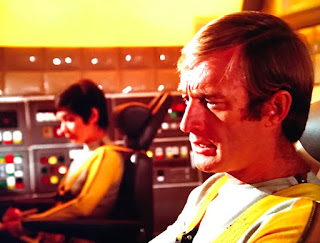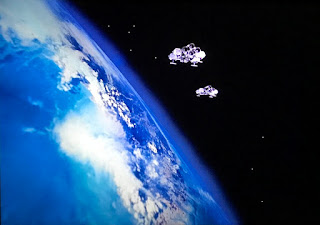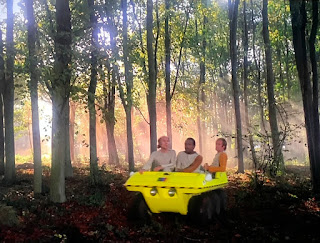


"Under the skin do you think we've changed all that much in 40,000 years?"
-Dr. Helena Russell-
"Do you think we ever will?"
-Professor Victor Bergman-
"Maybe, just maybe."
-Commander John Koenig-

Returning to the world of Space:1999 this writer is reminded of many reasons why the series has endured for decades. Certainly underneath the surface of the series are a great many science fiction ideas. Efforts are made to truly tap into extraordinary space adventure and couple that with a good story that asks questions yet refuses to spoon feed us back with easy answers. Lightning fast pacing was of little interest in the 1970s, but as science fiction series go, Space:1999 often had just the right balance of space with which to breathe and tell its story while engaging viewers with its share of suspense and visual wonder.

This leads me to our second major point of interest for the series and that is its surface detail and visual wonder. Space:1999 was skilled, thanks to its many outstanding talents and artisans, at giving viewers so much to enjoy visually and this in turn makes repeat viewing of the series a true joy.
Seeing Space:1999, Year One, Episode 15, The Full Circle reminds one of those many details and once again in this episode they are on full display.

The production design (Keith Wilson), uniform design (forever compliments of Rudi Gernreich) and visual effects (Brian Johnson) were second to none in the day and continue to astound this fan of science fiction even now. All of these aspects that made the series such a visual success are in full effect in The Full Circle.
There is tremendous model work, exterior shooting (filmed in Black Park outside of Pinewood Studios), the use of Space:1999's Eagles, the rare inclusion of the Moon Car or Buggy, signal markers (seen only in The Full Circle), commlocks and the application of the stun gun (which looks strikingly similar to my own staple gun--- see below).

Performances are wonderfully blended by all of the cast with notable turns by supporting cast members in the roles of Sandra Benes (Zienia Merton) and Alan Carter (Nick Tate) who really get an opportunity to shine here.
Still it's Barbara Bain, especially, and Martin Landau that play their roles with real physical power and essentially dialogue free relish as cave woman and cave man respectively. Bain is quite good in the part desperately attempting to communicate and does so exclusively through emotion and sound.

The Full Circle, not unlike many of the series episodes, is replete with visual details. Some may scoff at the idea of a series that is shiny on the surface, but this is in complement to its substance. Space:1999 indeed shined in filling the viewer's imagination with wonder. Seeing the episodes today in Blu-ray always reveals new layers or touches missed previously in years past.
This has caused me to remedy the missing Space:1999 Season Two on Blu-ray in North America by purchasing a region free Blu-ray player for an upcoming analysis of Season Two on Blu-Ray, available as a region locked UK only release. Otherwise grow old waiting for Season Two.
The Full Circle is particularly strong accented by the tribal score to this Bob Kellett directed entry, the second of three for the late director (see here). The music (the last composition by Barry Gray for the series) is the perfect complement serving to enhance the primal nature of the overarching plot.

Now I know we're in a world where objectifying women is no longer considered acceptable (thank God for Star Trek: The Original Series and episodes like this one with which to return), but when the primitives give Sandra Benes a leopard skin to wear this writer couldn't disagree more with today's unending political correctness. Who wouldn't want Sandra Benes in leopard skin? Space:1999 delivers on the occasional naked beauty in distress and it's a highlight here in The Full Circle. It's the kind of scene you see less and less of today.
As the mystery unfolds it's wonderful to see the make-up work throughout the episode, but it's clear the primitive versions of John Koenig and Helena Russell are recognizable to the Alphans which gives the entry greater credibility. Never for a minute are these people unrecognizable to the Alphans or the viewer and as good as they look they aren't meant to be. Bergman declares, "Kano I can't explain it, but I think that was John Koenig."

As alternate reality or mirror universe stories go, The Full Circle surrounding a Cro-Magnon people that are copies of existing Alphans is a solid and intriguing one. The story, the only one penned by Kesse Lasky Jr and Pat Silver, is handled with aplomb and walks that tightrope of space's unknown rather expertly. Of course we have an unknown mist that has a space-time impact on transforming the Alphans and no real answers about that.
Still, the experience of The Full Circle is an effective one transporting us in time for a genuinely enthralling experience that leaves us, once again, effectively pondering questions about ourselves and the evolution of behavior.

The Full Circle: B+.
Writer: Jesse Lasky Jr./Pat Silver.
Director: Bob Kellett.

Additional Commentary:
The Full Circle, whereby the Alphans visit the planet Retha (anagram for Earth), essentially tells an interesting tale about communication.
John Koenig notes at the episode's end, "Because we couldn't speak to each other, couldn't communicate, we misunderstood. Yet it was only us there." This is a profound message within The Full Circle. Again the story's premise is communication or in this case is founded on the inability of the Alphans to communicate to one another (or themselves). The idea of humans miscommunicating try as we might with each other.

The story's final denouement begs the question if we as human beings will ever be able to effectively communicate with one another entirely. It certainly seems, despite all of our technologies today, to be getting harder and harder to make that bridge.
So the whole exercise of The Full Circle is effectively watching the Alphans chase their tails literally in an effort to communicate and break down barriers. This story uses the inability of primitive man to speak with today's technological man and there is that visual contrast in play as well. But as evidenced today, technological man seems to have trouble speaking to technological man---each other. No matter of time between us, no alternate timelines and yet we still are ineffective in articulating understanding within each other despite all the tools.

There's also a beautiful moment in The Full Circle where primitive Dr. Helena Russell sees technological Commander John Koenig and reaches through the mist and finally speaks as she recognizes him. The moment is hopeful suggesting we can learn to communicate. We can overcome the barriers. Even john Koenig, too, remains hopeful by the end of the episode despite not having all the answers or knowing what the future holds. The message ultimately is there is always hope to break through the walls of misunderstanding. The Full Circle is a strong piece of entertainment with a strong message and works from a fine script with terrific direction.

Sure the mist is an easy way to present a kind of alien time warp, but it's effective and it certainly worked well for Stephen King.
Later in The Full Circle when Koenig is unconscious it is because he stumbled back through the portal reverting back to technological man from primitive man. Also, Sandra and Carter never enter the mist and thus are never transformed. So there are some great moments throughout the entry despite the inability to grasp the logic of simply walking through a mist for transformation or around the primordial mist that still seems to exist on our own plane of space-time. Space:1999 was indeed employing big concepts and big ideas.

Writer John Kenneth Muir notes, in his book Exploring Space:1999 (1997), the episode is beautifully photographed and was filmed in the Black Forest giving viewers of science fiction a genuinely fresh science fiction location that is something refreshingly alien when considering the usual location shooting of Vancouver, British Columbia for many shows or as Muir notes the Vasquez Rocks for so many Star Trek: The Original Series episodes like Arena. So The Full Circle really benefits from the fresh, original exterior shooting here.
The giant lizard foot made me wonder if the lizard come out of the mist? While the geek in me might have enjoyed seeing a Land Of The Lost styled moment in The Full Circle with all of that swirling fog, perhaps it was better left to the imagination. Still, I do love Land Of The Lost (1974-1976) so you never know.

Finally, The Full Circle stands shoulder to shoulder if not above its primitive story counterparts found in the good Stargate SG-1 episode The Broca Divide (S1, E5), in part because there is a greater intellectual depth to the former.
Author Muir notes The Full Circle is also far more astute in its attempt to offer an analysis on human nature than say Star Trek: The Next Generation episode Genesis (S7, E19).

Muir really offers some interesting points regarding commentary made on human behavior in the episode here.
It's not just an adventure story, but rather "The Full Circle is about the Alphans' behavior in relation to this bizarre transformation." With the violent confrontations presented to Alan Carter and Sandra Benes they respond in kind. Muir notes the story "makes a statement about the persisting nature of humanity." This is true and a fact. Violence certainly begets violence. One is forced to respond to violence with violence or accept the possibility of death. Thus the cycle or full circle continues despite evolution. This circle is indeed inevitable.

As Muir notes, Genesis "never enlightens the viewer about human nature." Without question Space:1999 is an example of quality science fiction where ideas and imagination combine to do the genre justice by allowing us to think.
Oops! That's the Banana Splits (1968-1970) Moon Buggy!



















No comments:
Post a Comment